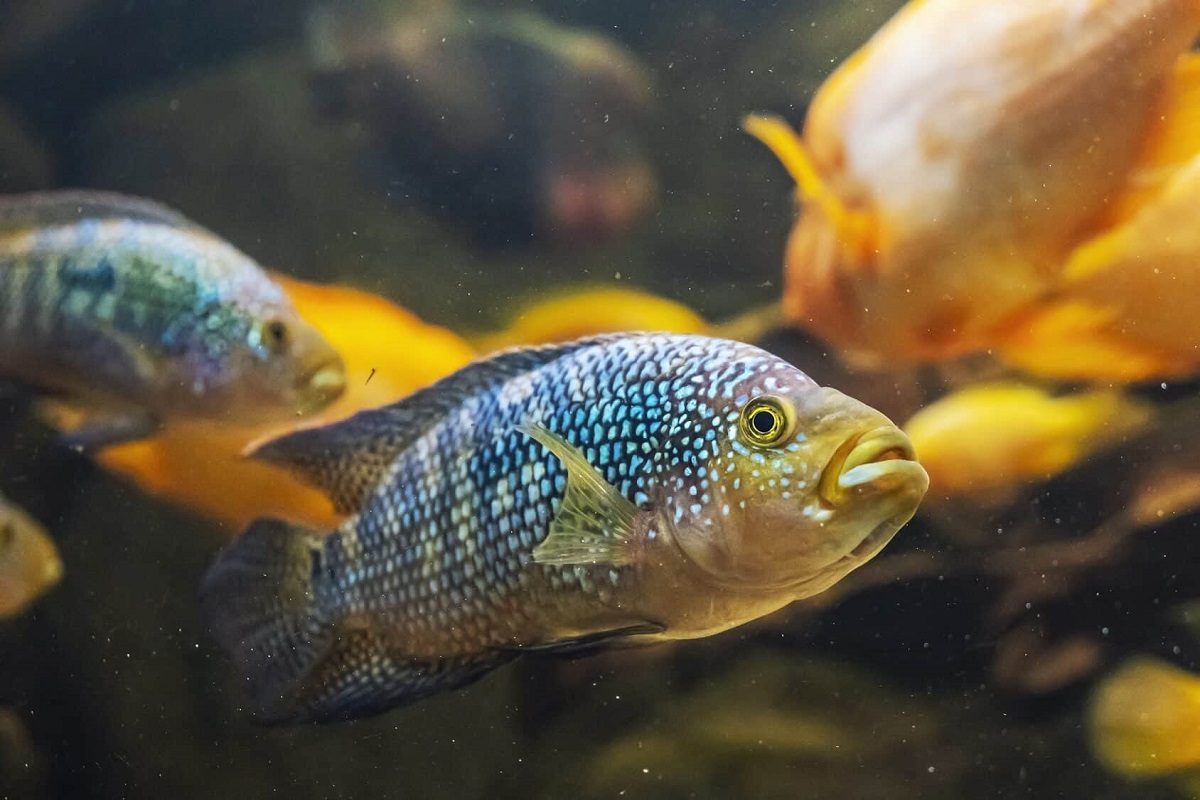Picking out the perfect fish for your first home aquarium can be tough, but there are a few key points to consider.
And the Jack Dempsey is definitely not one of them. This cichlid is for experienced fishkeepers.
We recommend the good old goldfish and guppies for beginners (or people who have children and pets who might come into contact with the tank water) as they are non-aggressive species. Or loaches if you want a low-maintenance, easy-to-feed bottom dweller.
The Jack Dempsey on the other hand is an active, aggressive fish that will add excitement to your tank.
This Central American native is known for its lively and aggressive behavior and can live up to 10 years in captivity.
Are you considering adding Jack Dempsey fish to your home aquarium?
If so, you need to read this care guide first. In this article, we will cover everything you need to know about these fascinating fish, including their origin and habitat, behavior, life span, care and tank requirements, breeding habits, diet, and common diseases affecting them.
Contents
Origin & Natural Habitat
Jack Dempsey cichlids are colorful fish that originated in slow-moving freshwater rivers in Mexico, Guatemala, Belize, and Honduras.
This fish can be found in tropical seas in the wild and prefers living in stagnant or sluggish moving water, such as ponds, bogs, swamps, wetlands, springs, and rivers.
The ideal environment for the Jack Dempsey cichlid fish is a year-round warm climate with enough supply of insects, worms, crustaceans, and little fish for cichlids to eat. This kind of fish also likes an environment with different substrates including mud, sand, rocks, or layers of decayed leaves.
Behavior and Temperament
Are Jack Dempsey Cichlids aggressive?
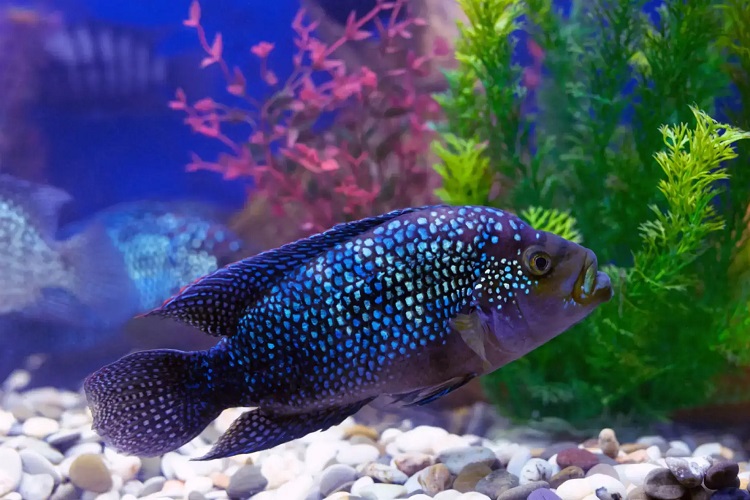
The Jack Dempsey cichlid is an active, playful fish that can be entertaining to watch. This kind of fish is highly aggressive and is not recommended for novice aquarists.
Jack Dempsey cichlid gets along with other fish in more populated aquariums, but becomes territorial in spaces with not a lot of fish, and will often battle for dominance.
Males are more territorial than females and will often attack other males in the tank. The Jack Dempsey cichlid is an active swimmer and will spend most of its time swimming in the upper levels of the tank.
Like humans, Jack Dempsey cichlids experience highs and lows of emotions, which are reflected in the colors. If their color drastically turns pale, it’s a sign that your fish is unhappy or is irritated about something in its environment.
Size & Lifespan
How Big Do Jack Dempsey Cichlids get?
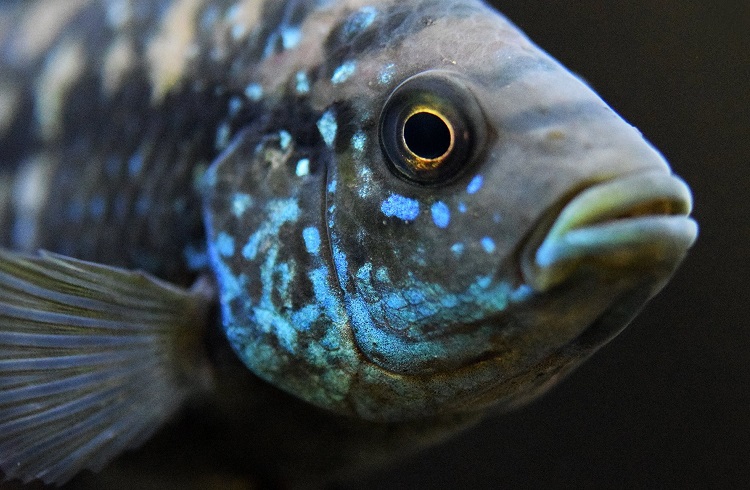
The Jack Dempsey cichlid fish has an average lifespan of 10 years in the home aquarium, but giving it quality care and a healthy environment can extend its life expectancy to 15 years.
This fish reaches a length of up to 12 inches and should be kept in groups of six or more fish. Male Jack Dempsey fish are bigger than females, as males grow up to eight inches long, and females grow up to six inches long.
Food & Diet
What can I feed my Jack Dempsey cichlid?
The Jack Dempsey cichlid is a carnivorous fish and will eat most types of fresh or frozen food. It prefers to eat live food, such as earthworms, brine shrimp, or bloodworms.
You can also feed it frozen food, such as krill, shrimp, or fish filets. You need to make sure that you give your fish plenty of protein and avoid plant-based food because those foods won’t meet the fish’s nutritional requirements.
How often should I feed my Jack Dempsey cichlid?
You should feed your Jack Dempsey cichlid with a pinch of food two or three times a day. Give them enough food that they can eat within two minutes, and make sure to remove leftover food to prevent overfeeding and to keep your aquarium clean.
Care & Tank Requirements
Ideal Water Parameters
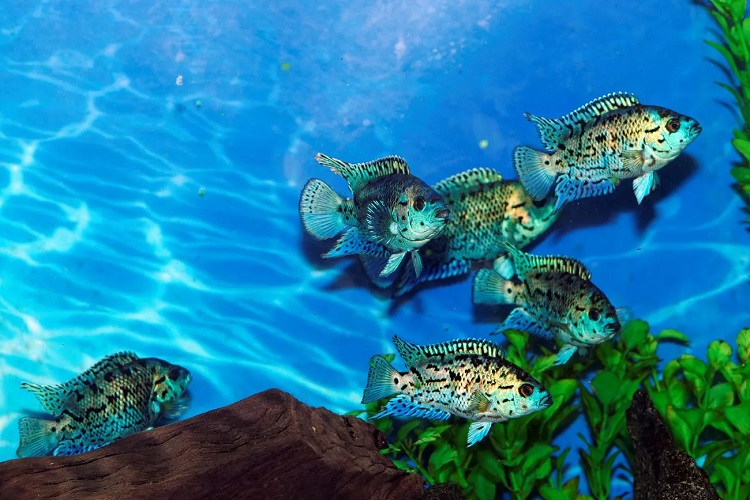
Your Jack Dempsey cichlid fish will live in a tropical climate and prefers water with a pH level of 6 – 7, temperature range of 23°C – 29°C, water hardness (GH) of 9–20 dGH, and carbonate hardness of (kH) 4-6 dGH.
Note that water hardness (GH) is the measure of the amount of calcium and magnesium and ions in the water, while carbonate hardness (kH) refers to the amount of carbonates and bicarbonates in your water that affects its buffering capacity.
Aquarium Size and Tank Requirements
One Jack Demsey fish requires a minimum tank size of 80 gallons, and for each additional fish, it will require an extra 55 gallons of water. You need to provide a large tank for your Jack Dempsey cichlids so they will have enough space and their own territories.
Better if you will choose a sandy and muddy substrate that mimics the fish’s wild habitat. It is advisable to add caves and hollow decorations as well so your Jack Dempsey fish will have a place to hide in.
Include floating plants so it can emulate the low-light waters and can provide shaded areas in the tank. Moreover, add deep-rooted plants in your aquarium in order to prevent the fish from pulling the plants out from the substrate.
Tips in Choosing the Best Aquarium for Your Jack Dempsey Fish
1. Choose an aquarium that is large enough for your Jack Dempsey fish.
When it comes to choosing an aquarium for your fish, size matters.
A too-small tank will create stressful conditions for your fish, while a too-large tank can be difficult to maintain. It’s important to find a balance that will allow your fish to thrive.
2. Choose an aquarium with a tight-fitting lid.
Jack Dempsey fish are delicate creatures that require a specific and carefully controlled environment in order to thrive. It is essential to choose one with a tight-fitting lid when choosing an aquarium.
A lid helps to keep unwanted visitors, such as cats and rodents, out of the aquarium. A tight-fitting lid is essential for creating a safe and healthy environment for your fish.
3. Choose an aquarium made of sturdy materials that will not easily break or shatter.
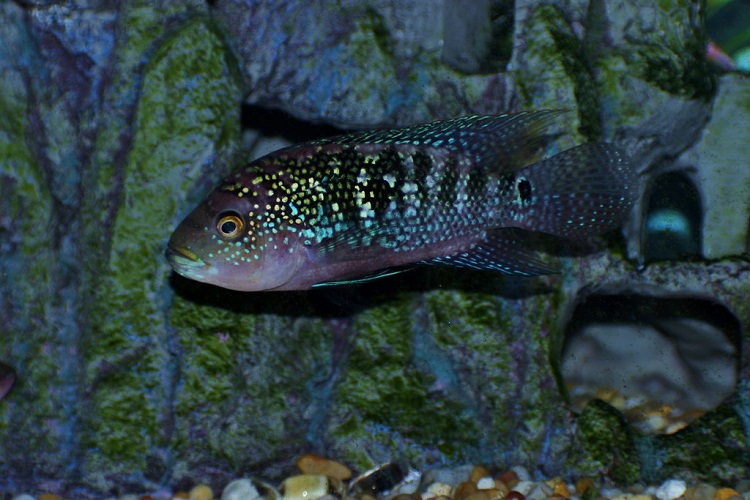
Anyone who has ever had an aquarium knows that they can be quite fragile. The last thing you want is for your fish tank to shatter, spilling water and fish all over the floor.
That’s why it’s important to choose an aquarium made of sturdy materials that will not easily break or shatter. Glass is the most popular material for aquariums, but it’s also the most fragile.
If you’re looking for an aquarium that will last, make sure to choose one made of acrylic. Acrylic is a much more durable option because it is clear, and you won’t have to worry about your fish being hidden from view. Your fish will thank you for it!
4. Choose an aquarium with a water filtration system.
A good filtration system will help to keep the water clean and clear, while also promoting the growth of healthy plants and fish.
There are a variety of different types of filtration systems available on the market, so it is important to choose one that is appropriate for the size and type of aquarium you have.
Canister filters are a good option for larger tanks. Be sure to maintain your filtration system regularly to ensure that your fish and plants remain healthy.
5. Choose an aquarium with a heater.
Jack Dempsey fish require a specific water temperature in order to thrive hence a heater is necessary to maintain the correct water temperature in your aquarium.
There are different types of heaters available on the market, so it is important to choose one that is appropriate for the size and type of aquarium you have.
If you live in a climate that experiences cold winters, it is essential to choose a heater that will keep your aquarium’s water temperature warm enough for your fish to survive.
Breeding
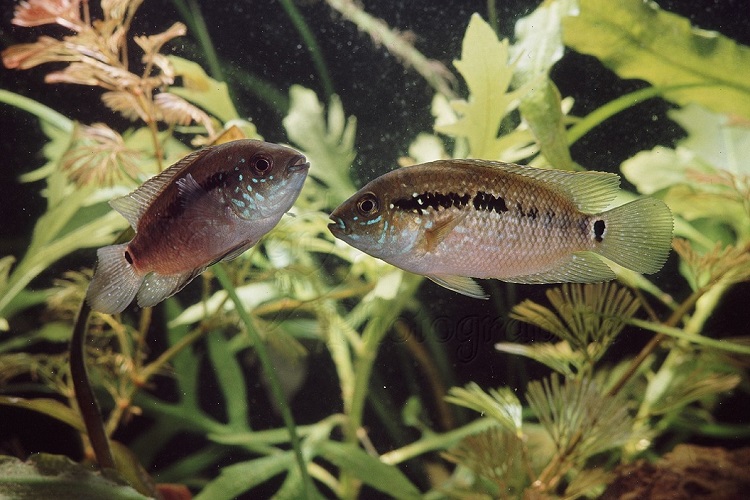
This kind of fish is a prolific breeder and will often spawn several times a year. Once they’ve grown to eight inches long, they become sexually mature. Its color becomes darker and bolder when breeding season comes.
Here are some tips on breeding Jack Dempsey cichlids:
1. Providing a Suitable Environment
The first step in breeding Jack Dempsey cichlids is to provide them with a suitable breeding environment.
This can be done by setting up a separate tank specifically for breeding or by partitioning off a section of the main tank. The breeding tank should have a pH of 7.0-8.0 and a water temperature of 76-82 degrees Fahrenheit.
2. Conditioning the Fish
The second step in breeding Jack Dempsey cichlids is to condition the fish. To do this, you need to gradually increase the water temperature in the breeding tank over a period of several days.
3. Introducing the Fish
Next step in breeding Jack Dempsey cichlids is to introduce the fish. You can do this by adding a few pregnant females to the breeding tank. The male will start defending his territory and the female will lay her eggs on a flat surface.
4. Caring for the Eggs
After the eggs are laid, it is important to keep them clean and free of fungus. You can do this by gently siphoning them into a container filled with water from the breeding tank. Be sure to change the water in the container frequently to keep it clean.
5. Raising the Fry
The fry will start hatching within a few days and will be able to swim and feed on their own within a few weeks. They can be fed baby brine shrimp or other commercially available fry food. Once the fry is three days old, remove the parents to prevent them from eating the fry.
Differences between Male and Female Jack Dempsey Fish
1. The male is typically larger than the female and has a more elongated body shape.
2. Male Jack Dempsey cichlids usually have bluish spots behind their eyes, and don’t have sports on the lower part of their mouth. Females Jack Dempsey cichlids, on the other hand, have big iridescent patches of color on the lowest part of their cheek.
3. Males have pointed edges to the tail fin, and females have round edges to their fin.
4. Anal and dorsal fins are pointed in males, while for females are rounded.
5. Female Jack Dempsey cichlids are generally smaller than the males. Females can reach around 6 inches, while males can grow as long as 8 inches.
Tank Mates
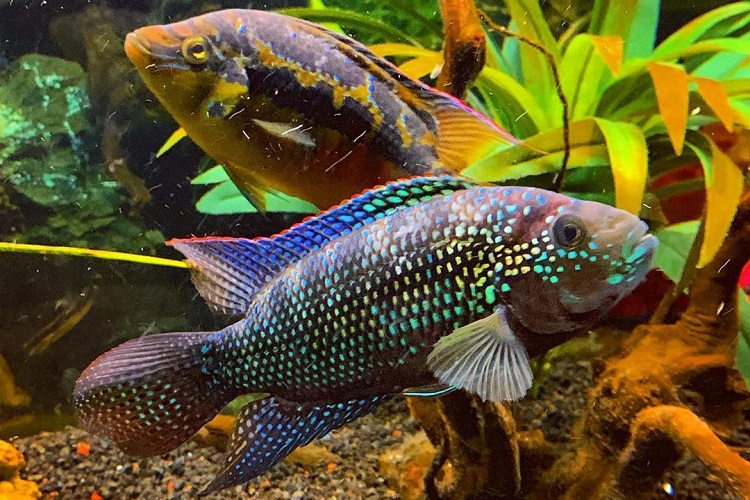
Community tanks are not advisable for Jack Dempsey fish because they can be very aggressive and territorial. Although it is still possible to put them in a tank together with other fish.
If you want to put your Jack Dempsey fish in an aquarium with other fish, it is important to choose tank mates that are compatible with them.
Some good tank mates for Jack Dempseys include other cichlids, rasboras, green terrors, barbs, clown loach, gouramis, common plecostomus catfish, firemouths, severums, among others. Avoid keeping them with fish that are aggressive or that can easily outcompete them for food.
Keep in mind that you should not keep two sexually mature male Jack Dempsey fish together because they will not get along and they will consistently fight until one or both of them are dead.
Common Diseases
Ich
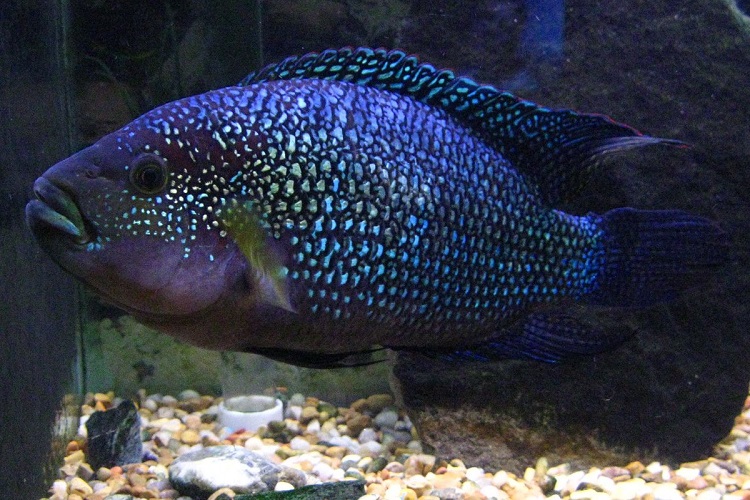
Ich is a type of parasitic infection that can be very difficult to treat. It can be brought by a tiny organism called Ichthyophthirius multifiliis that causes multiple white spots to your fishes’ skin and gills and can lead to rapid fish death. This is one of the few parasitic infections that are visible to the naked eye.
The most common way fish get ich is by coming into contact with an external parasite. This tiny organism can be found in most bodies of water and is often introduced into tanks when new fish are added.
Treatment
There are a few common steps people take when treating Ich in fish. The most important is to remove the fish from the tank and place them in a quarantine tank. This will prevent the parasites from spreading to other fish in the tank.
You should kill the parasites by raising the water temperature to between 82 and 86 degrees Fahrenheit. Also, you can try some medications such as malachite green or formalin. Be sure to follow the instructions on the medication bottle carefully.
Once your treatment is complete, put the tank temperature back to its normal level so you can reintroduce your Jack Dempsey fish to their original tank.
Hole in the Head
Also called freshwater head and lateral line erosion (FHLLE), this disease is common to freshwater fish and is being caused by the flagellate parasite Hexamita.
This disease primarily infects the intestinal tract of fish and then spreads to the kidneys, spleen, abdominal cavity, and bladder. One of the suspected causes of hole in the head is the presence of activated carbon.
These carbons can remove some of the minerals in the water, and this mineral imbalance can lead to malabsorption of the needed vitamins and minerals. Other factors can also cause your Jack Dempsey hole in the head disease like stress, poor water quality, and overcrowding.
Treatment
There are a few ways to treat hole in the head disease, but the most common is with a medication called Metronidazole. Metronidazole comes in either tablet or liquid form and can be purchased at most pet stores.
To treat a hole in the head, dissolve the appropriate dosage of Metronidazole in water and add it to your tank. Make sure to follow the instructions indicated on the package just to be safe.
You should also make sure to clean the aquarium and quarantine the fish as soon as possible because the disease is contagious. Avoid overcrowding your fish tank and improve the nutrition of your fish by giving them vitamins like A, B, D, and E.
Conclusion
After learning the basic care guide for Jack Dempsey fish, you are now ready to purchase one (or more) of these beautiful creatures for your home aquarium.
Setting up your very own aquarium and providing a comfortable home for your Jack Dempsey cichlids is laborious, but all worth it.
With a little bit of research and preparation, you can create an aquatic environment that is both healthy and satisfying for both you and your new pets.

Ian Sterling, founder of Fishlab.com, began his aquarium journey over 30 years ago, driven by a deep fascination for fish and their diverse personalities. His website, Fishlab.com, is dedicated to making fishkeeping accessible and enjoyable, offering beginner-friendly guidance, expert insights, and a community for aquarists to connect and share experiences.


